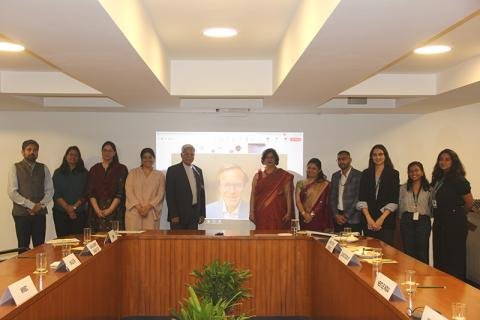Friday, 24 October 2025

Image Source: TERI
As India prepares to submit its updated Nationally Determined Contribution (NDC) ahead of COP30 in Belém, Brazil, a timely new policy brief unveiled in New Delhi is reframing the climate conversation—not as a cost, but as a once-in-a-generation business opportunity. Jointly released by The Energy and Resources Institute (TERI) and the We Mean Business Coalition (WMBC), the brief titled India’s 2035 Climate Target: A Business Opportunity for Growth and Global Leadership calls for embedding private sector dynamism into the very architecture of India’s next climate commitment. In a shift from technocratic ambition to executable realism, the brief positions Indian industry not as a peripheral stakeholder but as a principal architect of the country’s clean transition.
The policy brief draws a direct line from emissions targets to economic transformation. India’s private sector has already played a pivotal role in driving progress toward the 2030 goals—namely, reducing the emissions intensity of GDP by 45 per cent from 2005 levels and securing 50 per cent of installed power capacity from non-fossil sources. Now, as global climate ambition intensifies, the brief argues that India must raise the bar with a 2035 target that leverages domestic innovation, manufacturing capacity, and entrepreneurial appetite. Rather than viewing climate policy as a compliance challenge, the report treats it as a strategic lever to attract capital, future-proof industries, and position India as a global hub for low-carbon technologies—ranging from renewables and electric mobility to green hydrogen and the bioeconomy.
At the launch event, Dr Vibha Dhawan, Director General of TERI, underscored the urgency of institutionalizing industry participation in the climate process. “We should be the champions of India and help both domestic and global players by developing roadmaps that cater to the real needs of each sector. The time to align ambition with implementation is now,” she said. RR Rashmi, Distinguished Fellow at TERI, emphasized the need for clear, growth-oriented climate policies that can guide private investment. He described the brief as an actionable, sector-specific roadmap that aligns business priorities with national targets, while unlocking co-benefits such as operational efficiency, technological upgrades, and long-term competitiveness. According to him, India’s progress among the G20 is not just commendable—it’s proof that business-led climate action is already working.
WMBC’s Managing Director of Policy, Andrew Prag, framed the challenge in terms of investment confidence. “India’s private sector is already showing global leadership in clean energy and innovation. But to scale this, we need an ambitious 2035 target backed by sector-specific policies and long-term regulatory clarity. That’s what gives investors confidence to bet big on India’s green future.” He reiterated the Coalition’s commitment to helping design implementable, investible strategies tailored to India’s unique development needs.
The report is equally candid about the existing bottlenecks. Uncertain policies, fragmented financing, insufficient state-level implementation capacity, and limited support for small and medium enterprises are cited as persistent barriers. The brief calls for a strategic shift—toward policy predictability, deeper public-private coordination, and the creation of robust pipelines of investible projects. It highlights the importance of tools such as green taxonomies, carbon credit trading systems (CCTS), and mission-driven initiatives like FAME, PM E-DRIVE, and the National Green Hydrogen Mission in accelerating the transition.
Speakers from across India’s energy and infrastructure ecosystem echoed the report’s urgency and pragmatism. Dr Ashok Kumar, Deputy Director General of the Bureau of Energy Efficiency, noted that India is currently the only G20 country firmly on track to meet its Paris Agreement commitments. “This is the moment to strengthen, not soften, our climate resolve,” he said. Government officials also pointed out the need for the NDC to address overlooked sectors like cooling and energy storage. Dhiraj Kumar Srivastava, Chief Engineer at the Ministry of Power and nominee director at Energy Efficiency Services Ltd, advocated for including the buildings and cooling sectors in the next climate target. Manjari Chaturvedi, Chief Engineer at the Central Electricity Authority, highlighted storage as a critical enabler of renewable energy integration, stressing the need for storage solutions that reduce power curtailment and support round-the-clock clean energy supply.
What elevates the brief beyond the domestic context is its global framing. India, as a representative of the Global South and a rising economic power, is uniquely positioned to offer a replicable climate-development model. With its G20 presidency legacy still resonant and platforms like BRICS and COP30 on the horizon, India has a diplomatic window to showcase its 2035 target as a blueprint for harmonizing climate ambition with industrial policy. The report makes it clear: a well-designed, forward-looking NDC isn’t just a signal to the international community—it’s a strategic growth agenda at home.
Crucially, the brief moves the narrative from policy aspiration to policy architecture. It advocates for institutional mechanisms to embed private sector feedback into NDC formulation, enabling businesses to not just respond to climate targets, but co-create them. This is a marked evolution from India’s earlier climate cycles. If realized, it could unlock the scale of investment and innovation needed to turn climate ambition into real-economy outcomes.
The stakes are high. As the world’s most populous country and fastest-growing major economy, India’s climate path will reverberate far beyond its borders. What TERI and WMBC are proposing is not just a more ambitious climate target—but a smarter one. One that aligns with India’s development goals, addresses real market risks, and lets its business ecosystem lead from the front. If policymakers take the cue, India’s 2035 climate commitment could mark not just a decarbonization milestone, but a national inflection point—where sustainability becomes synonymous with competitiveness, resilience, and growth.